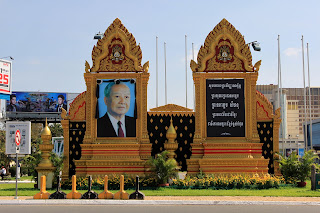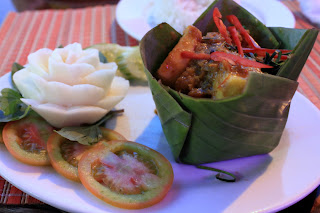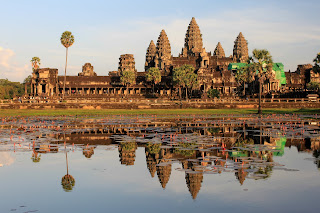One of our favorite things is the first day in a new country. We're on a high of excitement as each passing minute uncovers realizations about our new home. What kind of food is available? How much do things cost? Is there decent Internet connectivity? How many people speak English? What are some key local phrases? How good are the maps? What's the currency conversion? Can we drink the water? These are the moments when we're learning our new normal, and it's exciting. We will miss this greatly, as entering Cambodia was our last new country on this RTW adventure.
We started out Phnom Penh, which for a capital city, has a surprising number of naked kids running around. There are also a shocking number of people missing limbs…perhaps a result of Cambodia being the most densely landmined country in the world.
Cambodia has such a recently dark past, and there's no better place to learn about it than in Phnom Penh. From 1975-1978, it was here that a genocide was orchestrated which killed 2 million out of 8 million Cambodians in less than 4 years. The Khmer Rouge (AKA the bad guys), systematically wiped out anyone who was educated along with their families. Even people who wore reading glasses were deemed intelligent and thereby executed.
We visited the S21 Prison (formerly a high school) where innocent Cambodians were brought to be interrogated, tortured, and made to admit crimes they didn't commit.
Once they gave their confessions, they were transferred to Choeung Ek, also known as
The Killing Field. There are hundreds of killing fields all across Cambodia, but this particular one, just 15 kilometers outside the capital city is the most famous. 20,000 Cambodians were killed and buried in mass graves here less than 40 years ago. There are bones, teeth, and scraps of clothing still rising up to the surface each year as rains adjust the soil.
Surprisingly the Cambodian people are not reluctant to talk about it. They very much take the stance that if it's not openly discussed, it will be forgotten. They want everyone to know what happened so that it doesn't happen again.
To tour these two sites we reunited with Chan, our tuk tuk driver from the day before, who turned out to be an honest and hard-working guy. We talked with him over lunch about his uncle who was killed in the genocide (because he was studying medicine) and his parents who were spared (because they were so poor and uneducated). Chan beams when he talks about his 8-year old daughter who ranks at the top of her class. He has to meet a quota of $15-25 per day to pay for his kids' school and family expenses. We hired him to drive us around for the entire day at the rate of $15. Because he was a good person and didn't try to scam or up-sell us, we gave him more. He could not have been more appreciative.
The roads here are in really bad condition. We jokingly wonder how many months have been taken off of our lives from all the smog, exhaust, and dirt we breathed in along the way.
It's fun to see a country that is 95% Theravada Buddhist with Christmas decorations on every other street.
Cambodia's long-reigning king died just two months ago, so his picture hangs with black and white flowers all over the country.
His body is lying in state in the Royal Palace, so it was off limits to the public. Instead we got to see the neighboring Silver Pagoda courtyard.
It was also in Phnom Penh that I realized I had miscalculated our days. We had to cram a leisurely 2.5 days worth of sightseeing into a frenzied 1.5 days so that we could get north to the Angkor temples in time for Steve's birthday.
It was a 5.5-hour drive from Phnom Penh to Siem Reap on a minibus, and once again, we were shocked at the road conditions…stemming from the capital city no less.
If the vehicles would even remotely stick to some form of a lane, it would go a lot faster. But instead they all bunch up on a two-lane dirt highway. When an oncoming car plays chicken for long enough, they are forced to slow down and spread into a phenomenon called a single file line.
Things got really interesting during the last two hours when we had to drive through the dark, dodging pedestrians, bicycles, cars, dogs, and potholes. I always request to sit in the front seat because it helps with my motion sickness. Steve on the other hand would prefer to sit in the back. He can't bear to watch us drive straight into oncoming traffic at 60 mph and then swerve away at the last second. It's true; this kind of Cambodian driving would normally give us heart attacks. We still feel anxiety, but I have a hunch we've softened to it a bit by now.
Driving through the countryside was as fun as always. 85% of Cambodians are farmers and 90% of the land is for rice. The countryside is dominated by flat rice patties accentuated with thousands of tall palm trees.
Every country house is set high on stilts and has either a lily or lotus pond in their front yard. We passed babies in the front baskets of their parents bicycles and dusty roadside wedding receptions with women dressed in their fancy ethnic two-piece dresses. We also saw a few ponies pulling carts of hay along the way. Whoa…it totally took us back to South America where they are completely dependent on the horse. In Southeast Asia they prefer the water buffalo.
The bugs here are BAD, and we're not talking little mosquitoes. These are big, scary, hopping, hard-shelled insects. We are feeling a little jumpy these days. And speaking of bugs, they are definitely a part of the Cambodian cuisine. They eat big bugs at least 3 inches long, and humongous black spiders, too.
We preferred to stick with the traditional specialties of Lok Lak (well seasoned strips of beef served with onions, tomatoes and rice) or Amok (a custard of curry, coconut milk and fish served in a banana leaf bowl). We ate these two dishes every single day while we were in Cambodia and still weren't sick of them.
Since we celebrated my birthday at Machu Picchu, we figured what better way to celebrate Steve's than at Angkor, the greatest collection of ancient civilization in Southeast Asia. It was the center of the once powerful Khmer Empire which began in the 9th century – some 700 years before the Incas and Machu Picchu.
There are more than 100 ancient Khmer temples concentrated in the area around Siem Reap, and over the course of two days we toured through 16 of them. This is where the movie Tomb Rader was filmed, and it's easy to see why. This is no cleaned up Machu Picchu. These are jungle ruins left nearly as they were found. There has been some conservation work done, but it is largely wild and truly incredible.
These temples don't feel like the safest places in the world. They looked like they could cave in on our heads at any moment. In some places they're barely keeping it together.
Trees have begun to overtake the temples – baring a striking resemblance to an octopus wrapping its tentacles over and around the ancient buildings.
Near the entrances, landmine victims form bands and play traditional Khmer music to set the mood. They are accompanied by a symphony of cicadas so loud and shrill that they sound like a tile saw. The hawkers lurking around the temples are out of control, but once inside, the fun routes to explore were endless.
Occasionally we would hit dead ends.
It's hard to explain the scale of the Angkor temples. There are intricate carvings, not just saved for specials places, but which cover entire complexes. Today they are draped in moss, adding to the magic of it all.
In case you ever make the voyage, here were our favorite temples (in order):
Preah Khan – you could spend two hours here scrambling through the endless maze of ruins.
Banteay Kdei – another super fun one to explore, despite the fact that hardly anybody comes here.
Bayon – endearing because it has 4 large stone faces on each side of its 54 towers. That’s 216 faces to delight anybody with a camera.
Angkor Wat – easily the most famous of all Angkor temples, but the only reason is maybe because of its name and size. From a temple perspective, it's not nearly as fun to visit as the others, but it's still a must-do. Whether from a neighboring hilltop or in front of its lily pad pond, Angkor Wat is best appreciated for it's incredible beauty from a distance. At sunset, the light makes it glow.
Ta Phrom – famous for its overgrown trees, but it was under a lot of construction when we visited. It's overrun with tourists, so it is a bit harder to enjoy.
Banteay Srei – a long drive outside of Siem Reap. Known for it's intricate carvings, it's also small and too crowded with tourists. You've been warned. Best to arrive sometime after 9:30 and maybe you'll have it all to yourself.
In general we found that the temples where there were the least amount of tour groups were most enjoyable.
A fellow traveler in Vietnam had tipped us off to Golden Butterfly Villa, a hotel in Siem Reap that is only 2 months old. For $25 per night, we were treated like royalty. Every time we came home from the temples they showered us with cold Khmer tea, snacks, wet cloths to wash our hands, and warm welcoming smiles. It's been a long time since these two travelers experienced luxuries like this!
On Steve's birthday, they surprised him with a cake and a bowl of exotic fruits. What a memorable moment as three Cambodian hotel staffers sang him Happy Birthday in our room.
That same night we had Khmer foot massages on the street and then the next day complimentary massages back at our hotel. This particular form of Cambodian traditional massage involves a lot of slapping of muscles. It's actually quite funny.
Ancient temples, surprise cake, and being slapped around by Cambodian women. What better way to spend your special day. Happy Birthday Steve!





























3 Studies PROVE How Coconut Oil Kills Fat.
ReplyDeleteThis means that you actually kill fat by consuming coconut fats (including coconut milk, coconut cream and coconut oil).
These 3 researches from large medical journals are sure to turn the conventional nutrition world upside down!